NCERT Solutions Class 12 Biology Chapter 1 Sexual Reproduction in Flowering Plants have been provided below and is also available in Pdf for free download. The NCERT solutions for Class 12 Biology have been prepared as per the latest syllabus, NCERT books and examination pattern suggested in Class 12 by CBSE, NCERT and KVS. Questions given in NCERT book for Class 12 Biology are an important part of exams for Class 12 Biology and if answered properly can help you to get higher marks. Refer to more Chapter-wise answers for NCERT Class 12 Biology and also download more latest study material for all subjects. Chapter 1 Sexual Reproduction in Flowering Plants is an important topic in Class 12, please refer to answers provided below to help you score better in exams
Chapter 1 Sexual Reproduction in Flowering Plants Class 12 Biology NCERT Solutions
Students of Class 12 studying Biology are advised to carefully go through the NCERT questions and their detailed answers provided here for the chapter Chapter 1 Sexual Reproduction in Flowering Plants. The questions in the NCERT textbook for Class 12 Biology form an important part of school exams. These solutions for Class 12 follow a step-by-step approach and are highly beneficial for exam preparation. Scroll down to view detailed, chapter-wise solutions for Chapter 1 Sexual Reproduction in Flowering Plants and explore more NCERT solutions and free study materials for Biology and other subjects of Class 12.
Chapter 1 Sexual Reproduction in Flowering Plants NCERT Solutions Class 12 Biology
Question. Name the parts of an angiosperm flower in which development of male and female gametophyte take place.
Answer. Development of male and female gametophytes takes place in anther and ovary, respectively
Question. Differentiate between microsporogenesis and megasporogenesis. Which type of cell division occurs during these events? Name the structures formed at the end of these two events.
Answer.
| Microsporogenesis | Megasporogenesis |
| In this process, haploid microspores are formed from diploid microspore mother cell or pollen mother cell (MMC or PMC). |
In this process, haploid megaspores are formed from diploid megaspore mother cell (MMC). |
| It occurs inside the microsporangia or pollen sac of an anther. | It occurs inside the nucellus of ovule or megasporangium. |
| There are many microspore mother cells in a microsporangium. | There is generally a single megaspore mother cell in a megasporangium. |
| The four microspores formed from a single microspore mother cell are generally arranged in a tetrahedral structure. |
The four megaspores formed from a megaspore mother cell are arranged in the form of a linear tetrad. |
| All the four microspores arranged in a tetrahedral tetrad are functional. | Only one megaspore remain functional while the other three degenerates. |
| The microspores give rise to male gametophyte. |
The functional megaspore gives rise to female gametophyte. |
Question : Arrange the following terms in the correct developmental sequence: Pollen grain, sporogenous tissue, microspore tetrad, pollen mother cell, male gametes
Answer. Sporogenous tissue → Pollen mother cell → Microspore tetrad → Pollen grain → Male gametes.
Question. With a neat, labelled diagram, describe the parts of a typical angiosperm ovule.
Answer. An ovule is a female megasporangium where the formation of megaspores takes place.
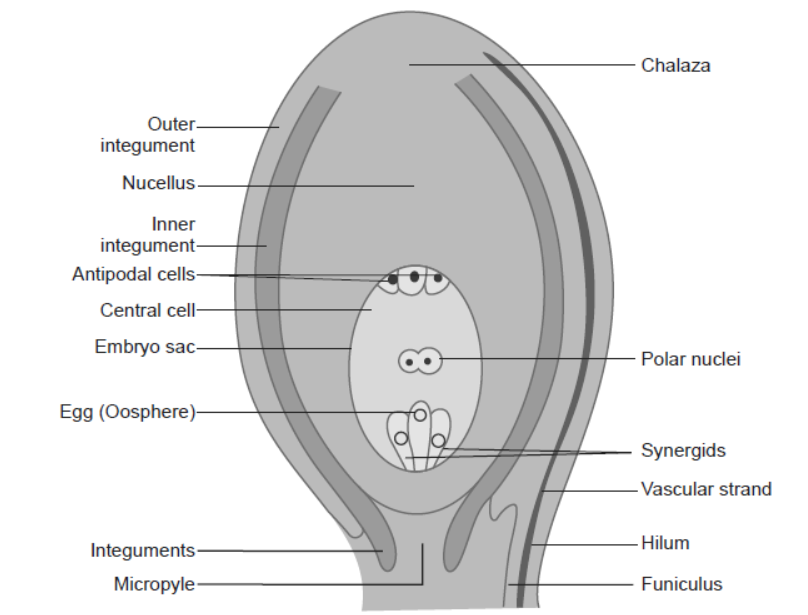
The various parts of an ovule are –
(1) Funiculus – It is a stalk-like structure which represents the point of attachment of the ovule to the placenta of the ovary.
(2) Hilum – It is the point where the body of the ovule is attached to the funiculus.
(3) Integuments –They are the outer layers surrounding the ovule that provide protection to the developing embryo.
(4) Micropyle – It is a narrow pore formed by the projection of integuments. It marks the point where the pollen tube enters the ovule at the time of fertilization.
(5) Nucellus – It is a mass of the parenchymatous tissue surrounded by the integuments from the outside. The nucellus provides nutrition to the developing embryo. The embryo sac is located inside the nucellus.
(6) Chalazal – It is the based swollen part of the nucellus from where the integuments originate.
Question. What is meant by monosporic development of a female gametophyte?
Answer. Out of the four megaspores, three degenerate and only one remains functional which develops into a female gametophyte or embryo sac. This is called monosporic development, i.e., when embryo sac develops from one single megaspore it is called monosporic embryo sac.
Question. With a neat diagram and explain the 7-celled, 8-nucleate nature of the female gametophyte.
Answer. Female gametophyte or embryo sac is a small oval structure that contains a 3-celled egg apparatus,3 antipodal cells and one binucleate central cell hence, it is 7-celled and 8-nucleate structure.
(i) Egg apparatus: It consists of two synergids and an egg cell towards the micropylar end. The cells of egg apparatus are uninucleate. Synergids towards its micropylar end have cellular thickenings called filiform apparatus that helps in guiding pollen tube into the synergids.
(ii) Antipodal cells: Chalazal end of embryo sac contain three cells of various shapes and sizes called antipodal cells.
(iii) Central cell: It is the single and largest cell which is bounded by a membrane of embryo sac. It contains two polar nuclei which later fuse to form diploid secondary nucleus. After fertilisation the central cell gets converted into triploid primary endosperm cell (PEC) which forms endosperm.
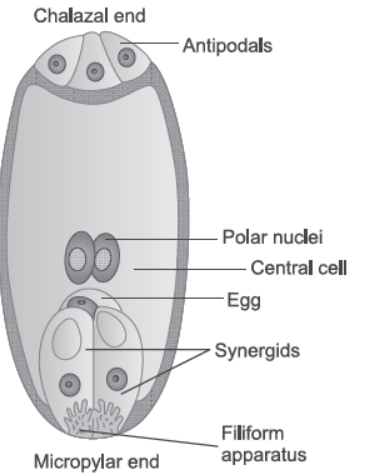
Question. What are chasmogamous flowers? Can cross-pollination occur in cleistogamous flowers? Give reasons for your answer.
Answer. Chasmogamous flowers are open flowers with exposed stamens and stigma which facilitate cross-pollination.
No cross-pollination occurs in cleistogamous flowers as these flowers are closed and never open and thus no transfer of pollen from outside to stigma of the flower is possible.
Question. Mention two strategies evolved to prevent self-pollination in flowers.
Answer. The two strategies evolved to prevent self-pollination in flowers are:
(i) Maturation of anthers and stigma at different time periods in a bisexual flower prevents selfpollination (dichogamy).
(ii) Production of unisexual flowers.
Question. What is self-incompatibility? Why does self-pollination not lead to seed formation in selfincompatible species?
Answer. Self-incompatibility or self sterility is the inability of an intersexual or bisexual plant to produce viable seeds on self-pollination, in spite of producing functional male and female gametes. Since,fertilisation does not take place, no seeds are produced. It is a genetic mechanism that prevents self pollen from fertilizing ovules by inhibiting pollen tube growth in pistil.
Question. What is bagging technique? How is it useful in a plant breeding programme?
Answer. It is the covering of female plant with butter paper germ to avoid their contamination from foreign pollens during breeding programme.
Question. What is triple fusion? Where and how does it take place? Name the nuclei involved in triple fusion.
Answer. Triple fusion is fusion of one male gamete and two polar nuclei (or secondary nucleus; if the two have already fused) in the central cell of embryo sac to form primary endosperm nucleus.
It takes place in the central cell of an embryo sac. Three nuclei are involved in triple fusion, i.e.,one male nucleus and two polar nuclei in the central cell.
Question. Why do you think the zygote is dormant for sometime in a fertilised ovule?
Answer. The zygote is dormant for sometime in a fertilised ovule because the embryo which is developed from zygote may obtain nutrition from endosperm.
Question. Differentiate between:
(a) hypocotyl and epicotyl (b) coleoptile and coleorhiza
(c) integument and testa (d) perisperm and pericarp.
Answer.
(a) Differences between hypocotyl and epicotyl
| Hypocotyl | Epicotyl |
| The region of the embryonal axis that lies between the radicle and the point of attachment of cotyledons is called hypocotyl. | The region of the embryonal axis that lies between the plumule and cotyledons is called epicotyl. |
| Hypocotyl pushes the seed above the soil in epigeal germination. | Epicotyl pushes the plumule above the soil in hypogeal germination. |
| It is an important component of embryonic root system. | It is an important component of embryonic shoot system. |
(b) Differences between coleoptile and coleorhiza
| Coleoptile | Coleorhiza |
| The shoot apex and few leaf primordia are enclosed in a hollow foliar structure in epicotyl region in monocots and is called coleoptile. |
The radicle and root cap are situated at the lower end of embryonal axis are enclosed by undifferentiated sheath called coleorhiza. |
| It comes out of the soil. | It remains inside the soil. |
| It emerges from the soil, turns green and carries out photosynthesis. | It remains in the soil and is non-green in colour. |
(c) Differences between integument and testa
| Integument | Testa |
| It is the protective covering of the ovule (nucellus). | It is the protective covering of the seed. |
| It is thin and living. | It is thick and dead. |
| It is part of pre-fertilisation. | It is part of post-fertilisation. |
(d) Differences between perisperm and pericarp
| Perisperm | Pericarp |
| It represents persistent remains of nucellus (of ovule) in the seed. |
It represents the wall of fruit formed by the ovarian wall. |
| It is a part that belongs to seed. | It is a part that belongs to fruit. |
| It is usually dry. | It can be dry or fleshy. |
Question. Why is apple called a false fruit? Which part(s) of the flower forms the fruit?
Answer. False fruits are those fruits in which accessory floral parts also contribute to fruit formation. In apple, the thalamus also contributes to fruit formation. Therefore, it is called a false fruit. The fruit develops from the ovary of the flower.
Question. What is meant by emasculation? When and why does a plant breeder employ this technique?
Answer. Emasculation is a practice of removal of stamens/anthers before the anther dehisces from bisexual flowers in female parent. A plant breeder employs this technique in the bud condition before the anthers begin to differentiate. It is required to prevent self-pollination.
Uses in plant breeding:
(i) Prevention of contamination and pollination of stigma of female flowers with foreign undesirable pollens.
(ii) Prevention of damage by animals.
Question. If one can induce parthenocarpy through the application of growth substances, which fruits would you select to induce parthenocarpy and why?
Answer. Only fleshy fruits like orange, watermelon, lemon, etc., should be selected as parthenocarpic fruits. Here seeds of fruits are irritant during consumption so seeds are removed so as to make the fruits even more valuable. It is easy to make fruit juices, jams, etc. with seedless fruits.
Question. Explain the role of tapetum in the formation of pollen grain wall.
Answer. Tapetum is the innermost wall layer of a microsporangium. It nourishes the developing pollen grains and also help in the formation of wall of pollen grains. The cells of tapetum secrete Ubisch granules that provide sporopollenin and other materials for exine formation.
Question. What is apomixis and what is its importance?
Answer. Apomixis is a type of asexual reproduction that mimics sexual reproduction to form seeds without fertilisation.
In apomictic seeds, parental characters are maintained in the progeny/offspring as there is no meiosis or segregation of characters.
If desired hybrid seeds are made apomictics the farmers can keep on using the hybrid seeds to raise new crops year after year.
NCERT Solutions for Class 12 Biology Chapter 2 Sexual Reproduction in Flowering Plants Multiple Choice Questions
Choose and write the correct option in the following questions.
Question. Choose the correct statement from the following.
(a) Cleistogamous flowers always exhibit autogamy
(b) Chasmogamous flowers always exhibit geitonogamy
(c) Cleistogamous flowers exhibit both autogamy and geitonogamy
(d) Chasmogamous flowers never exhibit autogamy
Answer. A
Question. A dicotyledonous plant bears flowers but never produces fruits and seeds. The most probable cause for the above situation is
(a) plant is dioecious and bears only pistillate flowers
(b) plant is dioecious and bears both pistillate and staminate flowers
(c) plant is monoecious
(d) plant is dioecious and bears only staminate flowers.
Answer. D
Question. Autogamy can occur in a chasmogamous flower if
(a) pollen matures before maturity of ovule
(b) ovules mature before maturity of pollen
(c) both pollen and ovules mature simultaneously
(d) both anther and stigma are of equal lengths.
Answer. C
Question. During microsporogenesis, meiosis occurs in
(a) endothecium
(b) microspore mother cells
(c) microspore tetrads
(d) pollen grains.
Answer. B
Question. In an embryo sac, the cells that degenerate after fertilisation are
(a) synergids and primary endosperm cell
(b) synergids and antipodals
(c) antipodals and primary endosperm cell
(d) egg and antipodals.
Answer. B
Question. From among the sets of terms given below, identify those that are associated with the gynoecium.
(a) Stigma, ovule, embryo sac, placenta
(b) Thalamus, pistil, style, ovule
(c) Ovule, ovary, embryo sac, tapetum
(d) Ovule, stamen, ovary, embryo sac
Answer. A
Question. In a flower, if the megaspore mother cell forms megaspores without undergoing meiosis and if one of the megaspores develops into an embryo sac, its nuclei would be
(a) haploid
(b) diploid
(c) a few haploid and a few diploid
(d) with varying ploidy.
Answer. B
Question. Function of germ pore is
(a) emergence of radicle
(b) absorption
(c) growth of pollen tube
(d) release of male gamete
Answer. C
Question. Starting from the innermost part, the correct sequence of parts in an ovule are
(a) egg, nucellus, embryo sac, integument
(b) egg, embryo sac, nucellus, integument
(c) embryo sac, nucellus, integument, egg
(d) egg, integument, embryo sac, nucellus
Answer. B
Question. From the statements given below choose the option that are true for a typical female gametophyte of a flowering plant.
(i) It is 8-nucleate and 7-celled at maturity
(ii) It is free-nuclear during the development
(iii) It is situated inside the integument but outside the nucellus
(iv) It has an egg apparatus situated at the chalazal end
(a) (i) and (iv)
(b) (ii) and (iii)
(c) (i) and (ii)
(d) (ii) and (iv)
Answer. C
Question. In a fertilised embryo sac, the haploid, diploid and triploid structures are
(a) synergid, zygote and primary endosperm nucleus
(b) synergid, antipodal and polar nuclei
(c) antipodal, synergid and primary endosperm nucleus
(d) synergid, polar nuclei and zygote.
Answer. C
Question. Dioecy states
(a) unisexuality of a flower
(b) bisexuality of a flower
(c) bisexuality of a plant
(d) unisexuality of a plant
Answer. D
Question. Which of the following structures are haploid in nature?
(a) nucellus and antipodals
(b) Microspore and antipodals
(c) Egg cell and antipodals
(d) Egg and central cell
Answer. C
Question. In angiosperms, male gametes are formed by the division of
(a) microspore mother cell
(b) microspore
(c) generative cell
(d) vegetative cell
Answer. A
Question. Filiform apparatus performs the function of
(a) opening the pollen tube
(b) guiding the pollen tube to egg
(c) entry of pollen tube into synergids
(d) prevents growth of more than one pollen tube
Answer. B
Question. In a cereal grain, the single cotyledon of embryo is represented by
(a) coleoptile
(b) coleorhiza
(c) scutellum
(d) hypocotyl
Answer. C
Question. Unisexuality of flowers prevent
(a) geitonogamy
(b) autogamy
(c) xenogamy
(d) both geitonogamy and xenogamy
Answer. B
Question. Transfer of pollen grains from the anther to the stigma of another flower of same plant is called
(a) geitonogamy
(b) autogamy
(c) xenogamy
(d) cross-pollination
Answer. A
Question. A particular species of plant produces light, non-sticky pollen in large numbers and its stigmas are long and feathery. These modifications facilitate pollination by
(a) insects
(b) water
(c) wind
(d) animals.
Answer. C
Question. The phenomenon observed in some plants wherein parts of the sexual apparatus is used for forming embryos without fertilisation is called
(a) parthenocarpy
(b) apomixis
(c) vegetative propagation
(d) sexual reproduction.
Answer. B
Question. From among the situations given below, choose the one that prevents both autogamy and geitonogamy.
(a) Monoecious plant bearing unisexual flowers
(b) Dioecious plant bearing only male or female flowers
(c) Monoecious plant with bisexual flowers
(d) Dioecious plant with bisexual flowers
Answer. B
Question. While planning for an artificial hybridisation programme involving dioecious plants, which of the following steps would not be relevant?
(a) Bagging of female flower
(b) Dusting of pollen on stigma
(c) Emasculation
(d) Collection of pollen
Answer. C
Question. Scutellum is
(a) grass embryo
(b) grass seed
(c) grass fruit
(d) grass cotyledon
Answer. D
Question. In the embryos of a typical dicot and a grass, true homologous structures are
(a) coleorhiza and coleoptile
(b) coleoptile and scutellum
(c) cotyledons and scutellum
(d) hypocotyl and radicle.
Answer. C
Question. In a typical complete, bisexual and hypogynous flower the arrangement of floral whorls on the thalamus from the outermost to the innermost is
(a) calyx, corolla, androecium and gynoecium
(b) calyx, corolla, gynoecium and androecium
(c) gynoecium, androecium, corolla and calyx
(d) androecium, gynoecium, corolla and calyx
Answer. A
Question. In angiosperms, a functional megaspore develops into
(a) embryo sac
(b) endosperm
(c) ovule
(d) pollen grain
Answer. A
NCERT Solutions for Class 12 Biology Chapter 2 Sexual Reproduction in Flowering Plants Assertion-Reason Questions
In the following questions a statement of assertion followed by a statement of reason is given. Choose the correct answer out of the following choices.
(a) Assertion and reason both are correct statements and reason is correct explanation for assertion.
(b) Assertion and reason both are correct statements but reason is not correct explanation for assertion.
(c) Assertion is correct statement but reason is wrong statement.
(d) Assertion is wrong statement but reason is correct statement.
Question. Assertion : The endosperm of angiosperms is generally triploid (3n).
Reason : It develops from primary endosperm nucleus formed by fusion of haploid male gamete and diploid secondary nucleus.
Answer. A
Question. Assertion : Dictogamy refers to maturation of male and female sex organs at different times.
Reason : This is a safeguard against cross fertilisation.
Answer. C
Question. Assertion : Megaspore mother cell undergoes meiosis to produce four megaspores.
Reason : Megaspore mother cell and megaspores are both haploid.
Answer. C
Question. Assertion : Entomophilous plants produce less pollen when compared to anemophilous plants.
Reason : The wastage of pollen is reduced to the minimum in entomophilous plants because of the directional pollination.
Answer. B
Question. Assertion : A structure of a typical microsporangium in angiosperms consists of four wall layers—epidermis, endothecium, middle layers and tapetum.
Reason : The function of outer three wall layers is protection and also help in dehiscence of anther to release pollen.
Answer. B
Question. Assertion : A pollen grains can withstand harsh conditions.
Reason : The exine of pollen grains is made up of sporopollenin which is resistant to high temperatures, strong acids or alkali as well as enzymatic degradation.
Answer. A
Question. Assertion : In plants, apomixis is a type of asexual reproduction that mimics sexual reproduction.
Reason : In apomixis seeds are produced without the fusion of gametes.
Answer. A
Question. Assertion : In coconut, the water represents the free nuclear endosperm and the white kernel represents the cellular endosperm.
Reason : PEN undergoes a number of free nuclear divisions which are followed by wall formation.
Answer. C
Question. Assertion : In monosporic type of embryo development megaspore is situated towards the micropylar end and remains functional.
Reason : In monosporic development the embryo sac develops from a single functional megaspore.
Answer. D
Question. Assertion : Microspore is the first cell of male gametophyte.
Reason : It is diploid in nature.
Answer. C
NCERT Solutions for Class 12 Biology Chapter 2 Sexual Reproduction in Flowering Plants Case-based/Source-based Question
1. Study the diagram given below and answer the questions that follow:
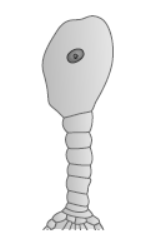
Question. Identify the figure given above.
Answer. It is a globular embryo of a dicot plant.
Question. Name the initial cell from which this structure has developed.
Answer. Zygote
Question. Draw the next mature stage and label the parts.
Answer.
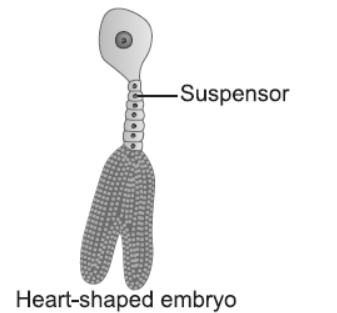
2. Fertilisation is essential for production of seed, but in some angiosperms, seeds develop without fertilisation.
Question. Give an example of an angiosperm that produces seeds without fertilisation.
Answer. In the members of family Asteraceae, seeds develop without fertilisation.
Question. Name the process.
Answer. This process is called apomixis.
Question. Explain the two ways by which seeds develop without fertilisation.
Answer. Two ways by which seeds develop without fertilisation are:
(a) In some species, the diploid (2n) egg cell is formed without reduction division and develops into embryo without fertilisation.
(b) In many varieties of Citrus and mango fruits, some of the nucellar cells surrounding the embryo sac start dividing, protrude into the embryo sac and then develop into embryos.
3. Given below is an enlarged view of one microsporangium of a mature anther.
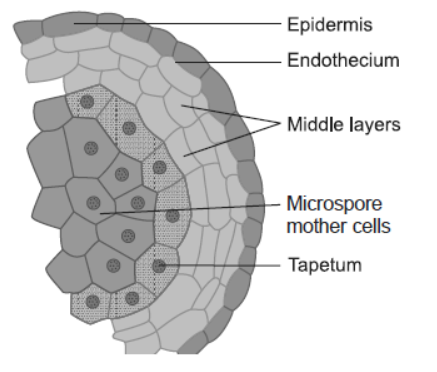
Question. An anther with malfunctioning tapetum often fails to produce viable male gametophytes.
Give one reason.
Answer. A malfunctioning tapetum is not able to provide optimum nutrition for the production of viable male gametophytes.
Question. The meiocyte of rice has 24 chromosomes. How many chromosomes are present in its endosperm?
Answer. 36 chromosomes
Question. State the reason why pollen grains lose their viability when the tapetum in the anther is malfunctioning.
Answer. Due to malfunctioning of tapetum, the developing pollen grain do not get proper nourishment and thus lose its viability.
4. Observe the figure of fertilised embryo sac of an angiosperm and answer the questions that follow.
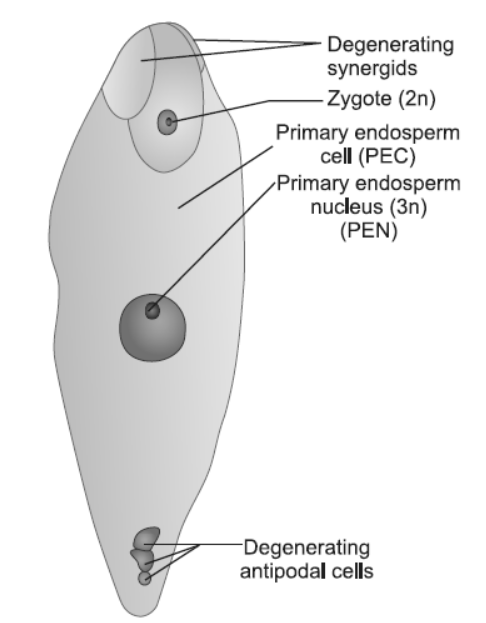
Question. In the embryos of a typical dicot and a grass, which are the true homologous structures?
Answer. Cotyledons and scutellum
Question. Normally one embryo develops in one seed but when an orange seed is squeezed many embryos of different shapes and sizes are seen. Mention how it has happened.
Answer. An orange seed has many embryos because of polyembryony.
Question. How many nuclei are present in a fully developed male gametophyte of flowering plants?
Answer. Three (one vegetative nucleus and two male nuclei)
5. Observe the diagram of pollen grain with germ tube and two male gametes given below.
Answer the questions that follow:
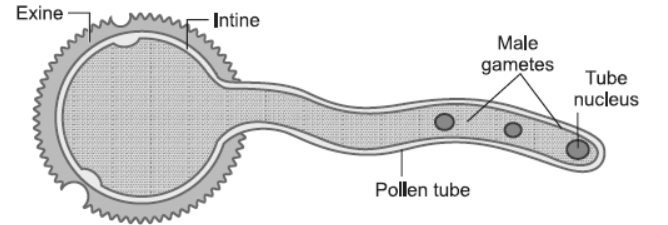
Question. How many pollen grains and ovules are likely to be formed in the anther and the ovary of an angiosperm bearing 25 microspore mother cells and 25 megaspore mother cells respectively?
Answer. 100 pollen grains and 25 ovules
Question. How do the pollen grains of Vallisneria protect themselves?
Answer. They have mucilaginous covering to prevent them from getting wet.
Question. If the stamens are well exposed, usually which mode of pollination the plant is expected to follow?
Answer. Wind-pollination
NCERT Solutions for Class 12 Biology Chapter 2 Sexual Reproduction in Flowering Plants Very Short Answer Questions
Question. Give an example of a plant which came into India as a contaminant and is a cause of pollen allergy.
Answer. Parthenium or Carrot grass.
Question. The microscopic pollen grains of the past are obtained as fossils. Mention the characteristic of the pollen grains that makes it happen.
Answer. The exine of pollen grains have an outermost hard layer composed of a chemical, sporopollenin.
It is highly resistant to high temperature, strong acids and alkali. So, pollen grains are obtained as fossils.
Question. State the function of filiform apparatus found in mature embryo sac of an angiosperm.
Answer. The filiform apparatus guides the pollen tube into the synergid.
Question. What is funiculus?
Answer. Funiculus is the stalk of ovule that attaches it to the placenta.
Question. How many germ pores are there in the pollen grains of monocots and dicots?
Answer. There are three germ pores in dicots and one in monocots.
Question. In maximum angiosperms pollen grains are shed at the two-celled stage. Name the 2 cells.
Answer. Vegetative cell and generative cell are the two-celled stage in which pollen grains are shed.
Question. Name the component cells of the ‘egg apparatus’ in an embryo sac.
Answer. Two synergids and an egg.
Question. Why do pollen grains of some flowers trigger ‘sneezing’ in some people?
Answer. They result in an allergic reaction.
Question. Name the tissue present in the fertilised ovules of angiospermic plants that supplies food and nourishment to the developing embryo.
Answer. Endosperm
Question. Draw a diagram of a matured microspore of an angiosperm. Label its cellular components only.
Answer.
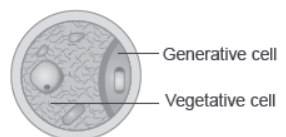
Generative cell
Vegetative cell
Question. How many cells are found in a typical embryo sac?
Answer. There are seven cells in a typical embryo sac. These are one egg cell, two synergids, three antipodal cells and a central cell.
Question. What is an anatropous ovule?
Answer. It is an ovule that is completely inverted through 180° such that the micropyle comes close to the base of the funiculus and nucellus remains straight.
Question. Papaver and Michelia both have multicarpellary ovaries. How do they differ from each other?
Answer. Papaver has syncarpous gynoecium whereas Michelia has apocarpous gynoecium.
Question. An anther with malfunctioning tapetum often fails to produce viable male gametophytes.
Give any one reason.
Answer. A malfunctioning tapetum does not provide enough nourishment to the developing male gametophytes and thus fail to produce viable male gametophytes.
Question. How is it possible in Oxalis and Viola plants to produce assured seed-sets even in the absence of pollinators?
Answer. By presence of cleistogamous flowers.
Question. A bilobed, dithecous anther has 100 microspore mother cells per microsporangium. How many male gametophytes this anther can produce?
Answer. The bilobed anther can produce 1600 male gametophytes.
Question. The diploid number of chromosomes in an angiospermic plant is 16. What will be the number of chromosomes in its endosperm and antipodal cells?
Answer. Endosperm—24 chromosomes, Antipodals—8 chromosomes.
Question. How do flowers of Vallisneria get pollinated?
Answer. In Vallisneria, the female flower stalk is long to reach the water surface to receive the pollen grains carried by water currents and then it gets coiled after pollination.
Question. How many microspore mother cells would be required to produce one hundred pollen grains in a pollen sac? And why?
Answer. 1 microspore mother cell undergoes meiosis to form 4 pollen grains. In order to produce 100 pollen grains, 25 microspore mother cells must undergo meiosis.
Question.What is pollen–pistil interaction and how is it mediated?
Answer. The ability of the pistil to recognise the pollen followed by its acceptance or rejection is called pollen–pistil interaction. It is mediated by chemical components of pollen interacting with those of pistil.
Question. How many microsporangia are present in a typical anther of an angiosperm?
Answer. Four
Question. Pea flowers produce assured seed sets. Give a reason.
Answer. Pea flowers are cleistogamous, i.e., anther and stigma lie close to each other in closed flowers. So when anthers dehisce in the flower buds, pollen grains come in contact with the stigma to effect pollination. Thus, assured seeds are produced in pea.
Question. Name the part of the flower which the tassels of the corn-cob represent.
Answer. Style and stigma
Question. Write the function of coleoptile.
Answer. It protects the plumule of the monocot embryo.
Question. Write the function of scutellum.
Answer. It provides nourishment and protection to the developing embryo.
Question. Name the part of gynoecium that determines the compatible nature of pollen grain.
Answer. Stigma
Question. Who discovered double fertilisation in angiosperms?
Answer. S. G. Nawaschin (1897) discovered double fertilisation in angiosperms.
Question. Name a plant in which dichogamy is found.
Answer. Magnolia
Question. What is nucellus?
Answer. The body of the ovule consists of a mass of parenchymatous cells rich in reserve food material which is called nucellus.
Question. Name the common function that cotyledons and nucellus perform.
Answer. Cotyledons and nucellus provide nourishment.
Question. Which are the three cells found in a pollen grain when it is shed at the three-celled stage?
Answer. One vegetative cell and two male gametes.
Question. What features of flowers facilitate pollination by birds?
Answer. Presence of a large quantity of nectar, bright colours of petal, fragrance and large flowers attract birds from long distances.
Question. Name the type of pollination in self-incompatible plants.
Answer. Xenogamy.
Question. Mention any two characteristics of pollen grains of plants such as maize and Cannabis.
Answer. (i) Pollen grains are small, dry and light in weight, non-sticky.
(ii) Pollen are produced in large numbers.
Question. Define parthenocarpy.
Answer. Parthenocarpy is an economically important process in which seedless fruit is formed without fertilisation, for example, banana.
Question. In a case of polyembryony, if an embryo develops from the synergid and another from the nucellus, which is haploid and which is diploid?
Answer. Synergid embryo is haploid and nucellar embryo is diploid.
NCERT Solutions for Class 12 Biology Chapter 2 Sexual Reproduction in Flowering Plants Short Answer Questions
Question. In a flowering plant a microspore mother cell produce four male gametophytes while a megaspore mother cell form only one female gametophyte. Explain.
Answer. Male gametophytes are formed by meiosis of single microspore mother cell whereas female gametophytes are formed by meiosis of single megaspore mother cell to produce 4 megaspores,out of which 3 degenerate and only one survives. The surviving megaspore undergoes mitotic division to form the female gametophyte.
Question. Name the organic materials the exine and intine of an angiosperm pollen grains are made up of. Explain the role of exine.
Answer. Exine is made up of sporopollenin and intine is made up of cellulose and pectin. Exine is the most resistant organic material and can withstand high temperature, acidic and alkali environment.
Question. Differentiate between the two cells enclosed in a mature male gametophyte of an angiosperm.
Answer. Differences between vegetative and generative cell of pollen grain
S.No. Vegetative cell Generative cell
(i) It is bigger in size. It is smaller and floats in the cytoplasm of vegetative cell.
(ii) It has food reserves. It gives rise to two male gametes.
Question. “Pollen grains in wheat are shed at 3-celled stage while in peas they are shed at 2-celled stage.”
Explain. Where are germ pores present in a pollen grain?
Answer. At the time of shedding wheat pollen consists of one vegetative and two male gametes, which is the 3-celled stage. While pea pollen consists of one vegetative and one generative cell which is the 2-celled stage. Germ pores are present on the exine where sporpollenin is absent.
Question. Gynoecium of a flower may be apocarpous or syncarpous. Explain with the help of an example each.
Answer. The gynoecium represents the female reproductive part of the flower. When there are more than one pistil, if the pistils are fused together, the flower is said to be syncarpous and if the pistils are free, it is said to be apocarpous. For example, pistil of Papaver is syncarpous and that of Michelia is apocarpous.
Question. Name all the haploid cells present in an unfertilised mature embryo sac of a flowering plant.
Write the total number of cells in it.
Answer. The haploid cells in an unfertilised mature embryo sac are: egg cell, synergids, antipodals and central cell. There are 7 cells in total.
Question. Draw a diagram of pollen grain with germ tube and two male gametes.
Answer.

Question. A pollen grain in angiosperm at the time of dehiscence from an anther could be 2-celled or 3-celled. Explain. How are the cells placed within the pollen grain when shed at a 2-celled stage?
Answer. In 2-celled stage the mature pollen grain contains one generative and vegetative cells, whereas in 3-celled stage one vegetative cell and two male gamete cells are present.
The generative cell being small floats in the cytoplasm of the vegetative cell. The pollen grains are shed at this 2-celled stage.
Question. In the T.S. of a mature anther given below, identify “a” and “b” and mention their function.
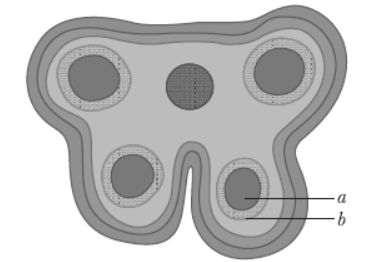
Answer. a—Sporogenous tissue: It forms pollen grains.
b—Tapetum: It provides nourishment to the developing pollen grains.
Question. Why does the zygote begin to divide only after the division of primary endosperm cell?
Answer. The zygote needs nourishment during its development. As the mature, fertilised embryo sac offers very little nourishment to the zygote, the primary endosperm cell (PEC) divides and generates the endosperm tissue which nourishes the zygote. Hence, the zygote always divides after division of PEC.
Question. Given alongside is an enlarged view of one microsporangium of a mature anther.
(i) Name ‘a’, ‘b’ and ‘c’ wall layers.
(ii) Mention the characteristics and function of the cells forming wall layer ‘c’.
Answer. (i) a = Endothecium, b = Middle layers, c = Tapetum
(ii) Tapetum provides nourishment to the developing pollen grains. The tapetal cells also secrete Ubisch granules that provide sporopollenin and other materials for exine formation.
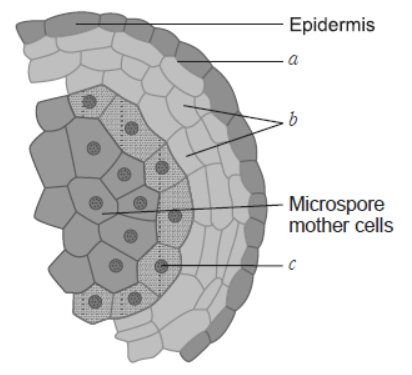
Question. Which is the triploid tissue in a fertilised ovule? How is the triploid condition achieved?
Answer. The triploid tissue in the ovule is the endosperm. Its triploid condition is achieved by the fusion of two polar nuclei and one nucleus of male gamete, referred to as triple fusion.
Question. Mention the ploidy of the different types of cells present in the female gametophyte of an angiosperm.
Answer. Ploidy of cells in female gametophyte
Cells in female gametophyte Their ploidy
1. Synergids Haploid
2. Egg Haploid
3. Polar nuclei Haploid
4. Antipodals Haploid
5. Central cell 2 haploid nuclei
Question. Write briefly the role of pollination in the growth and development in an angiosperm.
Answer. Pollination is transfer of pollen grains from anthers to the stigma of a flower. Pollination is prerequisite for fertilisation, events after fertilisation like endosperm development, seed setting and fruit formation. Thus, pollination plays an important role in the growth and development of angiosperms.
Question. Explain any two devices by which autogamy is prevented in flowering plants.
Answer. (i) Male and female flowers are present on different plants.
(ii) The stamens and stigma of a bisexual flower mature at different times.
(a) Anthers mature earlier than the stigma and release pollens.
(b) The stigma matures earlier than the anther.
(iii) Flowers are self-sterile or self-incompatible.
(iv) Chasmogamous flowers are present with exposed stamens and stigma which facilitate crosspollination.
Question. What is cleistogamy? Write one advantage and one disadvantage of it, to the plant.
Answer. Pollination occurring in closed flowers is referred to as cleistogamy.
Advantage: It ensures self-pollination and assured seed set formation in absence of pollinators.
Disadvantage: It does not allow cross-pollination. This can cause inbreeding depression as there will be no genetic variation.
Question. (a) List any two characteristic features of wheat flowers that make it a good example of wind pollination.
(b) It is observed that plant breeders carrying out wheat hybridisation often take pollen grains from the ‘pollen banks’. Do you agree ? Give one reason in support of your answer.
Answer. (a) Light pollen grains/Pollen grains more in number/well exposed stamen/feathery and sticky stigma/Numerous flowers are packed into an inflorescence. (Any two)
(b) Yes.Viability of wheat pollen grain is only 30 minutes and so it is stored in pollen bank for a long period of time for later use.
Question. List the post-fertilisation events in angiosperms.
Answer. (i) Development of endosperm
(ii) Embryogeny/development of embryo
(iii) Seed formation
(iv) Fruit formation
Question. Fill in the following labels with the type of cell function

Answer. X—Meiosis (Reduction division); A—Mitosis; B—Mitosis; C—Mitosis; D—Cells reorganised as polar nuclei, antipodals and egg apparatus.
Question. Mention the function of each of the following:
(a) Tassels of corn cob.
(b) Tapetum in the microsporangium.
Answer. (a) These are the stigma and style which wave in the wind to trap pollen grains.
(b) Provides nourishment to the developing pollen grains.
Question. List the two steps that are essential for carrying out artificial hybridisation in crop plants and why.
Answer. (a) Selection of parents: Only those plants should be selected which have desired traits.
Emasculation: Removal of anthers from flower before they are mature and dehisce.
(b) Crossing over: Pollen grains from selected male plant is collected and transferred to the female plant after which it is bagged.
Question. Explain the steps that ensure cross pollination in an autogamous flower.
Answer. A bisexual flower is emasculated at unopened stage to prevent self-pollination in the flower and it is bagged after emasculation to prevent contact of unwanted pollen grain with the stigma of the flower. Artificial pollination is then performed when the stigma is ready and the flower is rebagged.
Question. Geitonogamous flowering plants are genetically autogamous but functionally cross-pollinated.
Justify. Give similarity of geitonogamy with autogamy and xenogamy.
Answer. Geitonogamous flowers are genetically autogamous because both male and female flowers are borne on the same plant. They are functionally cross-pollinated because the pollen from one flower is transferred to the stigma of a different flower.
Question. Write the cellular contents carried by the pollen tube. How does the pollen tube gain its entry into the embryo sac?
Answer. Pollen tube carries two male gametes.
Pollen tube, after reaching the ovary, enters the ovule through the micropyle and then enters one of the synergids through the filiform apparatus which guides the entry of pollen tube into egg cell.
Question. State one advantage and one disadvantage of cleistogamy.
Answer. Advantage: Self-pollination is assured/Seed production is assured.
Disadvantage: Least variations observed/Leads to inbreeding depression.
Question. Name the product of fertilisation that forms the kernel of coconut. How does the kernel differ from coconut water?
Answer. Endosperm forms the kernel of coconut. The coconut water is free-nuclear endosperm whereas kernel is cellular endosperm.
Question. How does the Mediterranean orchid Ophrys ensures its pollination by bees?
Answer. The petals of the Ophrys resemble the female of a bee species in size, colour and odour. Male bee mistakes the Ophrys for female bee and tries to copulate. Few pollen grains adhered to the body of the male bee fall over stigma of the flower thereby leading to pollination showing sexual deceit.
Question. Why should a bisexual flower be emasculated and bagged prior to artificial pollination?
Answer. A bisexual flower is emasculated to prevent self-pollination in the flower and it is bagged after emasculation to prevent contact of unwanted pollen grain with the stigma of the flower.
| NCERT Solutions Class 12 Biology Chapter 2 Sexual Reproduction in Flowering Plants |
| NCERT Solutions Class 12 Biology Chapter 3 Human Reproduction |
| NCERT Solutions Class 12 Biology Chapter 4 Reproductive Health |
| NCERT Solutions Class 12 Biology Chapter 5 Principles of Inheritance and Variation |
| NCERT Solutions Class 12 Biology Chapter 6 Molecular Basis of Inheritance |
| NCERT Solutions Class 12 Biology Chapter 7 Evolution |
| NCERT Solutions Class 12 Biology Chapter 8 Human Health and Disease |
| NCERT Solutions Class 12 Biology Chapter 10 Microbes in Human Welfare |
| NCERT Solutions Class 12 Biology Chapter 11 Biotechnology Principles And Processes |
| NCERT Solutions Class 12 Biology Chapter 12 Biotechnology and its Applications |
| NCERT Solutions Class 12 Biology Chapter 13 Organisms and Populations |
| NCERT Solutions Class 12 Biology Chapter 14 Ecosystem |
| NCERT Solutions Class 12 Biology Chapter 15 Biodiversity and Conservation |
NCERT Solutions Class 12 Biology Chapter 1 Sexual Reproduction in Flowering Plants
The above provided NCERT Solutions Class 12 Biology Chapter 1 Sexual Reproduction in Flowering Plants is available on our website for free download in Pdf. You can read the solutions to all questions given in your Class 12 Biology textbook online or you can easily download them in pdf. The answers to each question in Chapter 1 Sexual Reproduction in Flowering Plants of Biology Class 12 has been designed based on the latest syllabus released for the current year. We have also provided detailed explanations for all difficult topics in Chapter 1 Sexual Reproduction in Flowering Plants Class 12 chapter of Biology so that it can be easier for students to understand all answers. These solutions of Chapter 1 Sexual Reproduction in Flowering Plants NCERT Questions given in your textbook for Class 12 Biology have been designed to help students understand the difficult topics of Biology in an easy manner. These will also help to build a strong foundation in the Biology. There is a combination of theoretical and practical questions relating to all chapters in Biology to check the overall learning of the students of Class 12.
You can download the NCERT Solutions for Class 12 Biology Chapter 1 Sexual Reproduction in Flowering Plants for latest session from StudiesToday.com
Yes, the NCERT Solutions issued for Class 12 Biology Chapter 1 Sexual Reproduction in Flowering Plants have been made available here for latest academic session
Regular revision of NCERT Solutions given on studiestoday for Class 12 subject Biology Chapter 1 Sexual Reproduction in Flowering Plants can help you to score better marks in exams
Yes, studiestoday.com provides all latest NCERT Chapter 1 Sexual Reproduction in Flowering Plants Class 12 Biology solutions based on the latest books for the current academic session
Yes, NCERT solutions for Class 12 Chapter 1 Sexual Reproduction in Flowering Plants Biology are available in multiple languages, including English, Hindi
All questions given in the end of the chapter Chapter 1 Sexual Reproduction in Flowering Plants have been answered by our teachers

